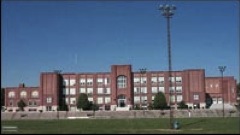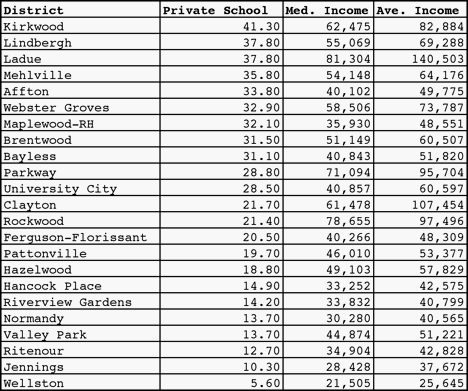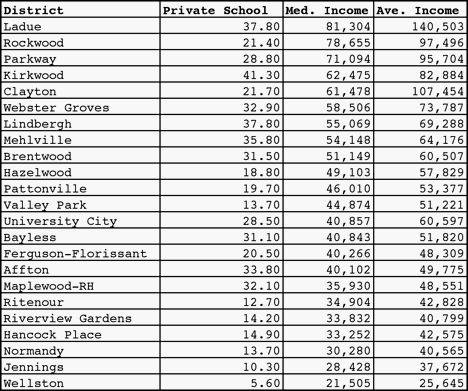Teachers should teach, not be police
Visit NBCNews.com for breaking news, world news, and news about the economy
The Sandy Hook massacre inside an elementary school has shocked us all. While we want everyone to be safe, we expect our youngest to be so inside their own school.
My children attend Clayton School District, one of the wealthier districts in St. Louis County. Like many local districts, it already has police officers at the high school and middle school. On Monday when I went to pick up my youngest, I saw a different police officer at the elementary school. I was a bit taken aback but assumed he was there to help parents feel more secure in the first few days after the Connecticut shooting. I am hopeful that the district does not spend money to keep police officers or even armed security at the elementary schools long-term as the expense would not be justified.
Other school districts such as Kirkwood and Florissant are considering police officers at elementary schools in their school safety reviews. I believe, however, that time and calm parents will help them spend limited resources wisely.
I do agree that schools should review safety procedures as they have after each school shooting and periodically otherwise. Safety experts learn from each experience. For example, whoever turned on the intercom at Sandy Hook, whether intentionally or not, alerted the teachers to the severity of the problem. These types of details are important to safety plans.
St. Louis County Police Chief Tim Fitch said that each officer costs a district about $50,000 for a nine month contract. (Really a 10-month contract) In order to afford that, the district would need to lay off a teacher at each elementary school. That is not a trade-off I am willing to make.
As an alternative to paying for police officers at the schools, some politicians such as Texas governor, Rick Perry, have advocated arming teachers as a way to make schools safer. On Sunday, Chief Fitch brought the gun control debate squarely to the St. Louis school districts.

The St. Louis Post-Dispatch followed up with a front-page story discussing Fitch's suggestion and other security possibilities. The local districts did not react with enthusiasm.
Fred Crawford, chief of security for the Parkway School District, said he would favor more police in schools over gun training for school officers.
The districts are right to hesitate. Teachers with guns in the classroom, even in a locked drawer, would bring a whole new set of problems to schools. That gun is more likely to be found and used against the teacher or other students, the teacher is not going to be as experienced as an active police officer, that gun is unlikely to be useful against a prepared killer like Adam Lanza with a bulletproof vest on, the teacher would be spending time helping students to safety, police might mistake teacher for intruder etc. I would not send my kids to school with a teacher carrying a gun or with a gun in a locked drawer in the classroom. If the gun is locked up in the office, I would still feel uncomfortable. Who would have access? Have the parents been notified who has access? Their training? The date and continuation of their training?
In addition, districts hire teachers to teach, not to act as security.
"I'm a former teacher and my daughter teaches currently. I want our teachers to be trained so that we can address the problems of literacy, so that we can improve our education system. Let the public safety people handle these other issues." --Rep. John Larson (D) Conn. on NOW with Alex Dec. 17, 2012
Districts should re-evaluate their safety plans and assess whether to add more security, depending on the local needs, not as an emotional reaction to a horrific situation. They should not, however, ask teachers to become that security force.
Canyon between high school and college expectations

(Photo by OliBac)
UMSL, Mizzou and the other UM-System campuses require students to have a 24 composite on the ACT or equivalent SAT scores to be accepted as freshmen. (They can be accepted with lower scores with high grades and class rank. See rubric.)
Unfortunately, our high schools are not graduating students at that level. The average ACT composite score in Missouri is 21.6 It's much lower at some of our metro school districts.
Clayton School District provides a good picture since they have all (or almost all at 92.48%) seniors take the ACT. In 2011, they had a composite score of 25.8, well above the state average and above the state university cut-off. However, the UM campus cut-off of 24 is a minimum, not a mean, so even many Clayton students wouldn't test high enough to be accepted.
Ferguson-Florissant had 68.75% of its seniors take the ACT in 2011 with a mean composite score of only 18.4. In order to be accepted to Mizzou or UMSL with that ACT score, a student also has to be in the top 14% of their class and have a 3.5 gpa in their core classes (no padding!).
Riverview Gardens seniors don't have much of a chance. In 2011, 58.74% of seniors took the ACT with a dismal composite score of 16.1. If their ACT score is below a 17, no matter what their class rank or grades in their core classes, they will not be admitted to Mizzou or UMSL. Being accepted to a 4-year state university will be challenging for most students from Riverview Gardens, nevermind the costs. There is a reason this district is currently unaccredited.
Every child should graduate from high school with the option of going to college, whether they choose to or not. The difference in expectations between high school graduation and college entrance is a canyon rather than a ravine for too many of our kids.
Let them eat...zucchini?
| The Daily Show With Jon Stewart | Mon - Thurs 11p / 10c | |||
| Little Crop of Horrors | ||||
| ||||
With the attention paid to our nation’s pathetic eating habits and the Obama’s organic garden, now seems to be a good time for the St. Louis area school districts to vastly improve their school lunches. Maplewood Richmond-Heights is in front of the “Race to the Top”, in terms of lunches anyway, as it implements its Healthy Eating with Local Produce grant in conjunction with St. Louis University.
"The kitchen staff has reshaped menus and already ordered their produce from the farmers in the Missouri Farmers' Union," superintendent Henke said. "Some of our high school students will have summer jobs helping process the foods this summer." (Gardening Teaches, Suburban Journals, 2 June 09)
This is in sharp contrast to most of the area school districts. Yes, they may offer some fresh fruit and vegetables at a food bar, a recent and welcome addition, but the overall menu is still weak.
Here’s a typical week’s menu. This one is for elementary schools from one week in May from Kirkwood school district, which uses Chartwells.

Here’s a menu from Chef Ann Cooper’s elementary menu (pdf). A daily menu might be chicken or veggie quesadilla, rice and beans, salad bar, 1% milk, fresh fruit.
Elem_calendar_sept
Like Maplewood, Kirkwood, U City, Ferguson-Florissant, St. Charles and Clayton have farmer’s markets within their borders. Let’s step up to the plate, schools.
Put that curriculum on the website!

Rockwood: detailed information on curriculum by content area, info on curriculum development, easy-to-use website
Mehlville: pdf of each grade and high school
MRH: pdf of each school level (elementary, middle, high) and content area, assessment report, easy-to-use website
Clayton: info on curriculum development including names of curriculum coordinators but not information on content level or grade level objectives
Ladue: info limited to elementary math under the district curriculum section
Ferguson-Florissant: no information on district site that I could find via browsing or by search, no info in at least two elementary schools (Airport Elementary, Bermuda Elementary)
SLPS: no information that I could find via browsing, no search available; no info in at least three elementary schools (Adams, Ashland and Cote Brilliante)
Since curriculum drives education, I applaud Rockwood and MRH for having comprehensive, easy-to-use curriculum sections on their websites. Clayton and Ladue have some catching up to do. Ferguson-Florissant and the SLPS are embarrassingly lacking in this area. While I didn’t look at every district’s website, I encourage educators to think about what they include and emphasize on their websites and the message that sends to their parents and broader community.
Why go private? Income? Religion? Ivy League?

Region plays a large role in the private school rate as Mehlville and Affton have a higher private school rate than wealthier west county districts. It’s a Catholic area, baby! (Lutheran South may have a role in the numbers for Affton.)

My theory is that the private school rate is dependent on multiple factors such as tradition, income and strong private school presences.
Ladue and Clayton are often considered sister schools with similar test scores, rankings, size, finances etc. However, the private school rates differences are striking. Yes, CBC moved to west county, but that was after the 2000 census. (Will these numbers change greatly in 2010?) I would have to dig more to figure out what Clayton and Rockwood have in common that is different than Ladue. I don’t know if Clayton’s numbers are related to the high number of people who walk or ride their bike to work, but I imagine Ladue’s high numbers are related to the two Ivy league feeder private schools within its borders. This is the land that inspired Confessions of a Prep School Mommy Handler by Wade Rouse.
Yes, of course, there’s a general correlation to income although the exceptions are more interesting.

Look at Hazelwood and Brentwood with similar median incomes but different private schools rates or Affton and Ferguson-Florissant. I think the North County region just doesn’t have the tradition of attending private schools at the same rate. It’s not income there.
Why is Lindbergh’s private school rate (top 3) higher than it’s median income or quality would lead someone to hypothesize? I’m going back to the Catholic tradition.
Why is Kirkwood, a high quality school district, the number one private school sender? It’s not in the top three wealthiest by median or four by average. It’s numbers are more in line with Webster or Lindbergh. By tradition I would have put it with Webster, but, apparently, it aligns more with Lindbergh.
I have so many ideas for more posts now—how about that ranking of school districts by how many people go to work by walking or biking? Is there any significance that I can pull out from that? Who knew I could find census data so entertaining.